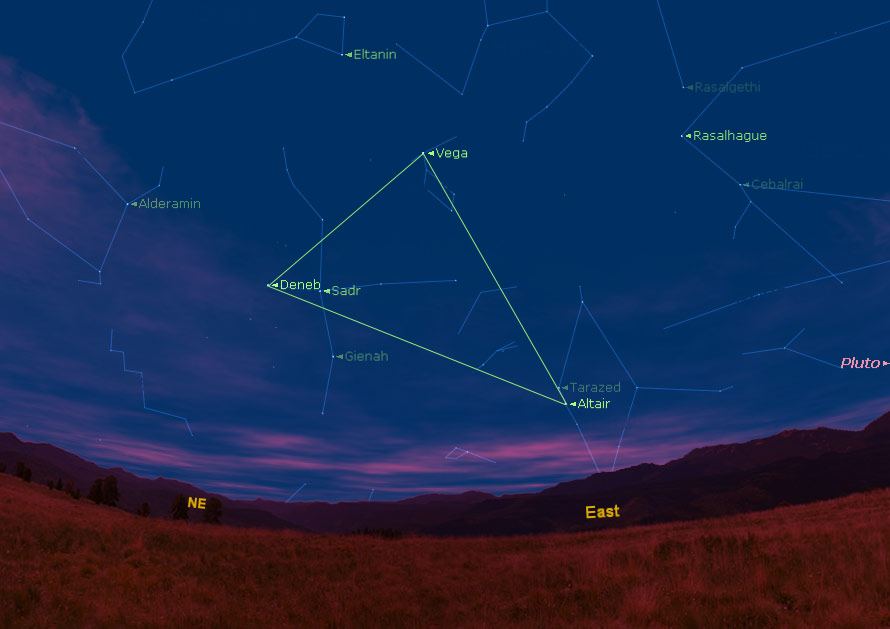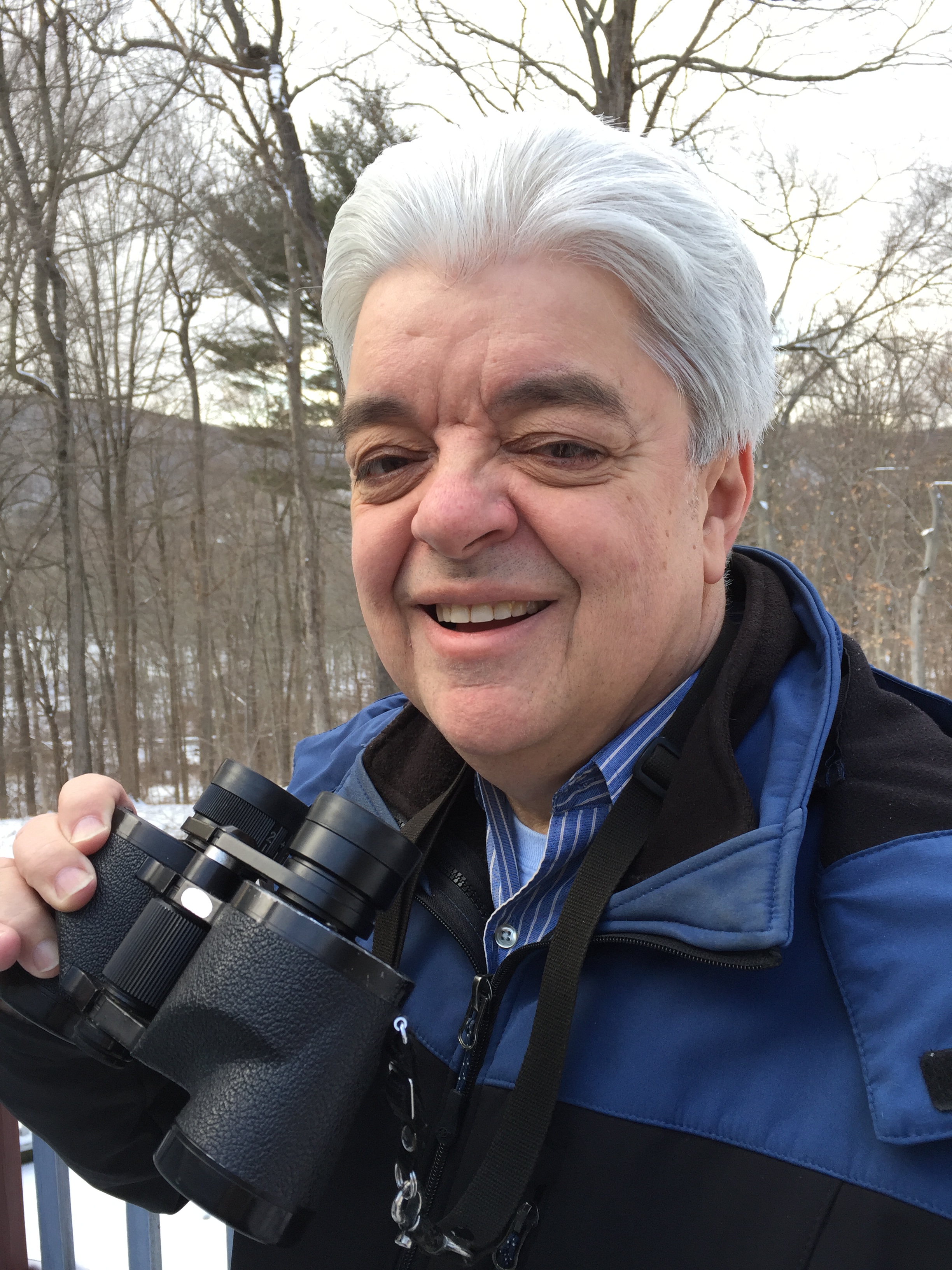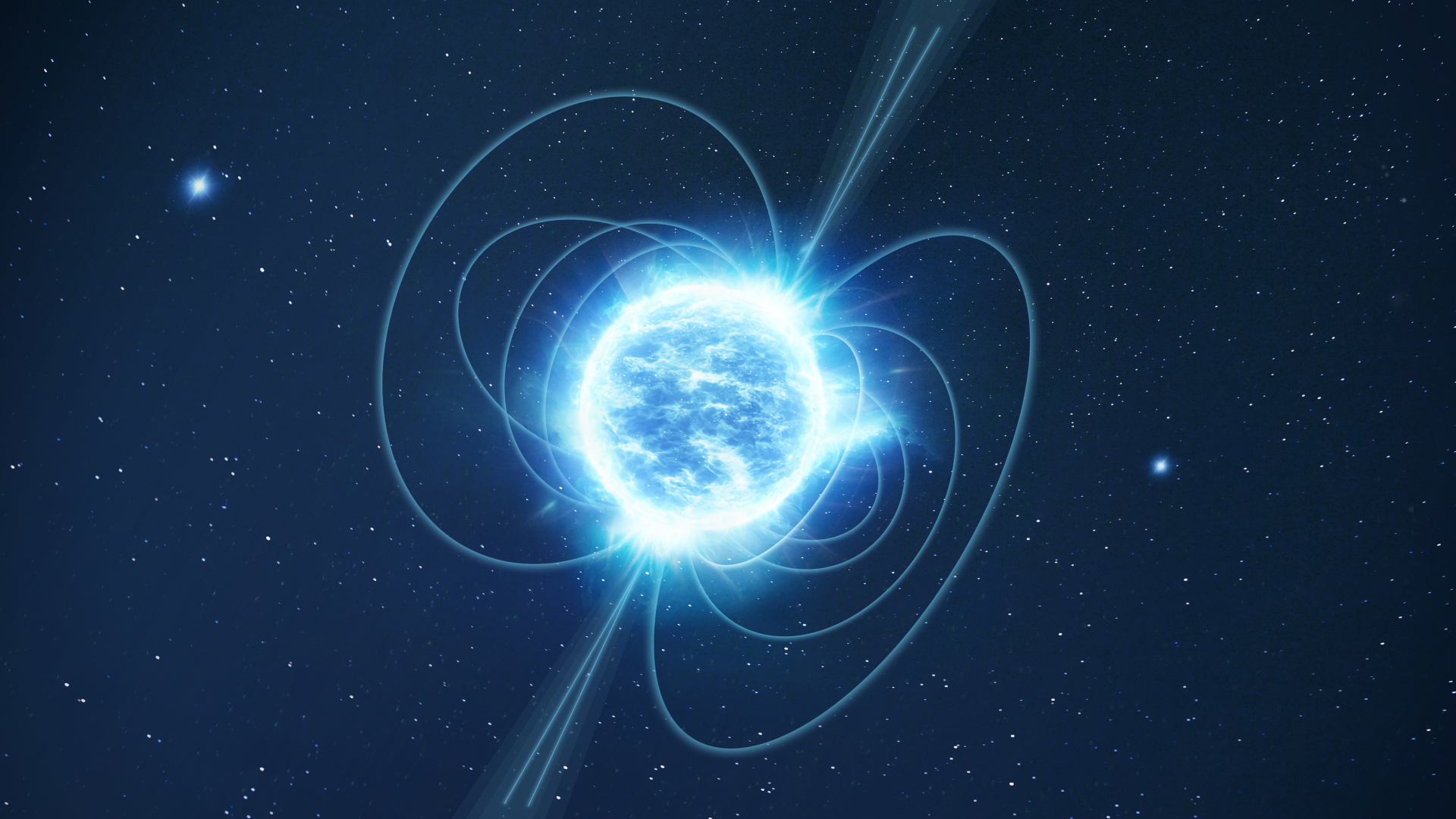'Summer Triangle' Promises Skywatching Treat

With summer in full swing in North America, the famous star formation knownas the "Summer Triangle" can be found low in the eastern sky asdarkness falls this week.
This huge triangle is composed of three of the brightest stars in the sky,each the brightest star in its own constellation. The pattern is nearlyisosceles, which means it appears as a triangle with two equal-length sides.
The brightest in the bunch is the bluish-white star Vega in theconstellation Lyra (The Lyre). Next up is theyellow-white Altair in Aquila, the Eagle. Finally there is the white star Deneb in the constellation Cygnus, or the Swan. The starsappear in that order, as the twilight sky grows dark. (This graphic shows howto identify the Summer Triangle stars.)
When clear skies allow, the Summer Triangleis one of the favorite parts of the sky for most sky watchers, perhaps becauseof its sheer simplicity in contrast to overabundance of bright stars found inthe wintertime sky.
If you are just gettingstarted in astronomy, and especially as you watch for the first stars tocome out after sundown during the coming weeks, you are not very likely toconfuse the Summer Triangle with anything else.
Moreover, since this area of the sky is far removed from the zodiac, wherethe bright planets roam, it does not have any strange "stars"temporarily altering its familiar pattern, as Mars has done to Leo over thepast few weeks.
Who named the Summer Triangle?
Breaking space news, the latest updates on rocket launches, skywatching events and more!
So who was the first to coin the moniker "Summer Triangle?"
In doing some research, it turns out that this celestial designation appearsto be of relatively recent origin. Romanian astronomer Oswald Thomas(1882-1963) described Vega, Altair and Deneb as"Grosses Dreieck" (Great Triangle) in thelate 1920s and "Sommerliches Dreieck"(Summerly Triangle) in 1934.
In the classic New Handbook of the Heavens, (McGraw-Hill BookCompany, New York, 1941), authors Hubert J. Bernhard, Dorothy A. Bennett andHugh S. Rice do speak of Vega, Altair and Deneb asa "? brilliant triangle composed of three of the 20 brightest starsin the heavens."
But in a twist, the triangle is designated not as a summer star pattern.Instead, it is described under the chapter "Autumn and Winter Stars,"since, as the authors point out, the "big triangle" passes overheadon September evenings.
That is indeed the case, although it is only during the summer months ofJune and July that the triangle is visible for the entire night, from dusk untildawn.
So just exactly where did the popular "Summer Triangle" nameoriginate?
Mystery solved?
Hans Augusto "H.A." Rey (1898-1977), is probably best known for he and his wife Margret?s creation of the mischievous littlemonkey, "Curious George."
But in 1952, Rey wrote a constellation book titled, The Stars ? A New Wayto See Them (Houghton-Mifflin, Boston). In it, Rey made reference to thetriangle on Chart 13, where he clearly sketched the star formation out, butunder his description of Aquila, the Eagle, he wrote:
"Altair, Vega (in the Lyre), and Deneb (inthe Swan) form a huge right triangle, known to all navigators."
Still, though, no "Summer Triangle."
The name finally came two years later, in 1954, Rey published anotherHoughton-Mifflin book, Findthe Constellations, which was designed for young children. It is here,that (finally) we find a reference to the Summer Triangle.
In his Sky-View 3 description, Rey wrote: "Vega, Altair. And Deneb form the famous ?Summertriangle,? with a right angle at Vega."
Rey always noted that the Summer Triangle was a "navigator?slandmark." One of the most notable books on celestial navigation is the AmericanPractical Navigator by Nathanial Bowditch.
As it turns out, this publication does indeed make reference to the triangleformed by Vega, Deneb and Altair . . . but not as theSummer Triangle.
Back in 2005, I received an e-mail from a gentleman in Missouri who told me:
"One summer evening in 1958 (as I recall) my father pointed out asatellite passing through the Summer Triangle. When I asked him what that washe explained that it was a group of three navigationalstars taught to him when he studied as a naval aviator.
"He showed me a three-ring binder, dating from about 1944, thatcontained star charts provided by the Navy. I remember seeing several charts onwhich Vega-Deneb-Altair were connected by lines andmarked ?Summer Triangle.'"
"Sir Patrick?s Triangle?"
In the United Kingdom, many credit the legendary British astronomer, SirPatrick Moore as the first to coin the term.
In his 1992 book Fireside Astronomy (John Wiley and Sons), Moore writes:
"Many years ago, during a television broadcast, I introduced thenickname of "the Summer Triangle" and everyone now seems to use theterm, even though it is completely unofficial and the three stars of theTriangle are not even in the same constellations."
While there is no reference in his book, to an exact date when he made thisstatement, it couldn?t have been any earlier than April 1957. That?s whenMoore?s monthly television program "The Sky at Night" made its debuton BBC television ? but this came at least three years after Rey first referredto the Summer Triangle.
Susan Rose, a past President of New York?s Amateur Observers? Society (AOS),is a good friend of Moore.
"Patrick had not read Rey?s books prior to using the phrase during oneof his programs in 1958. When he used it, it caught on. It would seem that theycoined it independently of each other but because of his TV presence, it becamemore widely known and therefore associated with him."
- The Brightest Stars in the Sky
- Gallery - Stars and Galaxies
- Beginner Astrophotography Telescopes
Joe Rao serves as an instructor and guest lecturer at New York's HaydenPlanetarium. He writes about astronomy for The New York Times and otherpublications, and he is also an on-camera meteorologist for News 12Westchester, New York.
Join our Space Forums to keep talking space on the latest missions, night sky and more! And if you have a news tip, correction or comment, let us know at: community@space.com.

Joe Rao is Space.com's skywatching columnist, as well as a veteran meteorologist and eclipse chaser who also serves as an instructor and guest lecturer at New York's Hayden Planetarium. He writes about astronomy for Natural History magazine, Sky & Telescope and other publications. Joe is an 8-time Emmy-nominated meteorologist who served the Putnam Valley region of New York for over 21 years. You can find him on Twitter and YouTube tracking lunar and solar eclipses, meteor showers and more. To find out Joe's latest project, visit him on Twitter.
